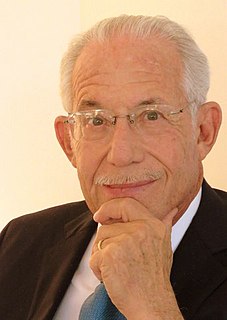Related Research Articles

Proceedings of the National Academy of Sciences of the United States of America is a peer-reviewed multidisciplinary scientific journal. It is the official journal of the National Academy of Sciences, published since 1915, and publishes original research, scientific reviews, commentaries, and letters. According to Journal Citation Reports, the journal has a 2020 impact factor of 11.205. PNAS is the second most cited scientific journal, with more than 1.9 million cumulative citations from 2008 to 2018. In the mass media, PNAS has been described variously as "prestigious", "sedate", "renowned", and "high impact".

Stanley Norman Cohen is an American geneticist and the Kwoh-Ting Li Professor in the Stanford University School of Medicine. Stanley Cohen and Herbert Boyer were the first scientists to transplant genes from one living organism to another, a fundamental discovery for genetical engineering. Thousands of products have been developed on the basis of their work, including human growth hormone and hepatitis B vaccine. According to immunologist Hugh McDevitt, "Cohen's DNA cloning technology has helped biologists in virtually every field". Without it, "the face of biomedicine and biotechnology would look totally different."

Factor XI or plasma thromboplastin antecedent is the zymogen form of factor XIa, one of the enzymes of the coagulation cascade. Like many other coagulation factors, it is a serine protease. In humans, Factor XI is encoded by the F11 gene.

A metabolic network is the complete set of metabolic and physical processes that determine the physiological and biochemical properties of a cell. As such, these networks comprise the chemical reactions of metabolism, the metabolic pathways, as well as the regulatory interactions that guide these reactions.

HLA-B is a human gene that provides instructions for making a protein that plays a critical role in the immune system. HLA-B is part of a family of genes called the human leukocyte antigen (HLA) complex. The HLA complex helps the immune system distinguish the body's own proteins from proteins made by foreign invaders such as viruses and bacteria.

Platelet factor 4 (PF4) is a small cytokine belonging to the CXC chemokine family that is also known as chemokine ligand 4 (CXCL4). This chemokine is released from alpha-granules of activated platelets during platelet aggregation, and promotes blood coagulation by moderating the effects of heparin-like molecules. Due to these roles, it is predicted to play a role in wound repair and inflammation. It is usually found in a complex with proteoglycan.

Ananda Mohan Chakrabarty, Ph.D. was an Indian American microbiologist, scientist, and researcher, most notable for his work in directed evolution and his role in developing a genetically engineered organism using plasmid transfer while working at GE, the patent for which led to landmark Supreme Court case, Diamond v. Chakrabarty.
Macrophage migration inhibitory factor (MIF), also known as glycosylation-inhibiting factor (GIF), L-dopachrome isomerase, or phenylpyruvate tautomerase is a protein that in humans is encoded by the MIF gene. MIF is an important regulator of innate immunity. The MIF protein superfamily also includes a second member with functionally related properties, the D-dopachrome tautomerase (D-DT). CD74 is a surface receptor for MIF.

Bruce Alan Beutler is an American immunologist and geneticist. Together with Jules A. Hoffmann, he received one-half of the 2011 Nobel Prize in Physiology or Medicine, for "their discoveries concerning the activation of innate immunity".

RE1-Silencing Transcription factor (REST), also known as Neuron-Restrictive Silencer Factor (NRSF), is a protein which in humans is encoded by the REST gene, and acts as a transcriptional repressor. REST is expressly involved in the repression of neural genes in non-neuronal cells. Many genetic disorders have been tied to alterations in the REST expression pattern, including colon and small-cell lung carcinomas found with truncated versions of REST. In addition to these cancers, defects in REST have also been attributed a role in Huntington Disease, neuroblastomas, and the effects of epileptic seizures and ischemia.

POU domain, class 4, transcription factor 1 (POU4F1) also known as brain-specific homeobox/POU domain protein 3A (BRN3A), homeobox/POU domain protein RDC-1 or Oct-T1 is a protein that in humans is encoded by the POU4F1 gene.

Proteasome maturation protein is a protein that in humans is encoded by the POMP gene. It is a short-lived maturation factor required for 20S proteasome subunit biogenesis.

Transcription factor HIVEP3 is a protein that in humans is encoded by the HIVEP3 gene.

The history of chronic fatigue syndrome is thought to date back to the 19th century and before.
Human betaherpesvirus 7 (HHV-7) is one of nine known members of the Herpesviridae family that infects humans. HHV-7 is a member of Betaherpesvirinae, a subfamily of the Herpesviridae that also includes HHV-6 and Cytomegalovirus. HHV-7 often acts together with HHV-6, and the viruses together are sometimes referred to by their genus, Roseolovirus. HHV-7 was first isolated in 1990 from CD4+ T cells taken from peripheral blood lymphocytes.

Anthony L. Komaroff is an American physician, clinical investigator, editor, and publisher. He serves as the Distinguished Simcox-Clifford-Higby Professor of Medicine at Harvard Medical School and Senior Physician at Brigham and Women's Hospital in Boston.

William A. Haseltine is an American scientist, businessman, author, and philanthropist. He is known for his groundbreaking work on HIV/AIDS and the human genome. Haseltine was a professor at Harvard Medical School where he founded two research departments on cancer and HIV/AIDS. Haseltine is a founder of several biotechnology companies including Cambridge Biosciences, The Virus Research Institute, ProScript, LeukoSite, Dendreon, Diversa, X-VAX, and Demetrix. He was a founder chairman and CEO of Human Genome Sciences, a company that pioneered the application of genomics to drug discovery. He is the president of the Haseltine Foundation for Science and the Arts and is the founder, chairman, and president of ACCESS Health International, a not-for-profit organization dedicated to improving access to high-quality health worldwide. He was listed by Time Magazine as one of the world's 25 most influential business people in 2001 and one of the 100 most influential leaders in biotechnology by Scientific American in 2015.
J. (Joseph) Donald Capra is an American immunologist, physician-scientist, and was the 4th full-time president (1997–2007) and later, president emeritus, of the Oklahoma Medical Research Foundation (OMRF) in Oklahoma City, OK. While president, he helped to raise over $100 million and spearheaded major research growth in grants funded and faculty recruited to the institution.
Steven N. Goodman is an American Professor of Epidemiology and Population Health and of Medicine at the Stanford School of Medicine. He has extensively contributed to foundations of scientific and statistical inference within the biosciences, and in 1999 he coined the term "p-value fallacy".
Richard Palmiter is a cellular biologist. He was born in Poughkeepsie, NY and later went on to earn a BA in Zoology from Duke University and a PhD in Biological Sciences from Stanford University. He is employed with the University of Washington where he is a professor of biochemistry and genome sciences. His current research involves developing a deeper understanding of Parkinson's disease. His most notable research is a collaboration with Dr. Ralph Brinster where they injected purified DNA into a single-cell mouse embryo, showing transmission of the genetic material to subsequent generations for the first time.
References
- ↑ "Immunological Immunity: The Rosenfeld Case | News | The Harvard Crimson". www.thecrimson.com. 28 February 1975. Retrieved 21 December 2018.
- 1 2 Chedd G (1974-12-26). "Transfer factor - Another scandal?". New Scientist . 64 (929). pp. 920–1.
- 1 2 Reinhold, Robert (16 December 1974). "Student's Forgery Perils Key Harvard Research". The New York Times.
- 1 2 "Science: The Model Student". Time. 30 December 1974.
- ↑ Rosenfeld, S; Dressler, D (June 1974). "Transfer factor: a subcellular component that transmits information for specific immune responses". Proceedings of the National Academy of Sciences of the United States of America. 71 (6): 2473–7. Bibcode:1974PNAS...71.2473R. doi: 10.1073/pnas.71.6.2473 . PMC 388481 . PMID 4135308.
- ↑ Dressler, D; Rosenfeld, S (November 1974). "On the chemical nature of transfer factor". Proceedings of the National Academy of Sciences of the United States of America. 71 (11): 4429–34. Bibcode:1974PNAS...71.4429D. doi: 10.1073/pnas.71.11.4429 . PMC 433899 . PMID 4530993.
- ↑ Dressler, D; Potter, H (January 1975). "Authors' statement: the existence and nature of "transfer factor/be/". Proceedings of the National Academy of Sciences of the United States of America. 72 (1): 409. Bibcode:1975PNAS...72..409D. doi: 10.1073/pnas.72.1.409-b . PMC 432317 . PMID 1088829.
- ↑ Potter, H; Rosenfeld, S; Dressler, D (December 1974). "Transfer factor". Annals of Internal Medicine. 81 (6): 838–47. doi:10.7326/0003-4819-81-6-838. PMID 4530646.
- ↑ Dressler, D; Potter, H (February 1975). "Transfer factor: warning on uncertainty of results". Annals of Internal Medicine. 82 (2): 279. doi:10.7326/0003-4819-82-2-279_1. PMID 1115452.
- ↑ Reinhold, Robert (29 December 1974). "Research Pressures Are Great, As Are the Rewards". The New York Times.